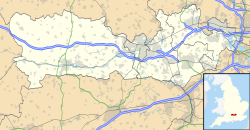| Site of Special Scientific Interest | |
 | |
| Location | Berkshire |
|---|---|
| Grid reference | SU 499 782 [1] |
| Coordinates | 51°30′04″N1°16′59″W / 51.501°N 1.283°W |
| Interest | Biological |
| Area | 15.9 hectares (39 acres) [1] |
| Notification | 1983 [1] |
| Location map | Magic Map |
Ashridge Wood is a 15.9-hectare (39-acre) biological Site of Special Scientific Interest south-west of Compton in Berkshire. [1] [2] It is in the North Wessex Downs, which is an Area of Outstanding Natural Beauty. [3]
The wood is a surviving section of a once larger ancient coppiced woodland, although part was planted with conifers during the 20th century. It has many flowering woodland plants, including an abundance of Spiked Star-of-Bethlehem Ornithogalum pyrenaicum. [3]
A visit by the Reading & District Natural History Society in June 2009 identified 34 species of flowering plants, 7 different lichens on ash trees within the wood, and 22 species of insects. [4]
